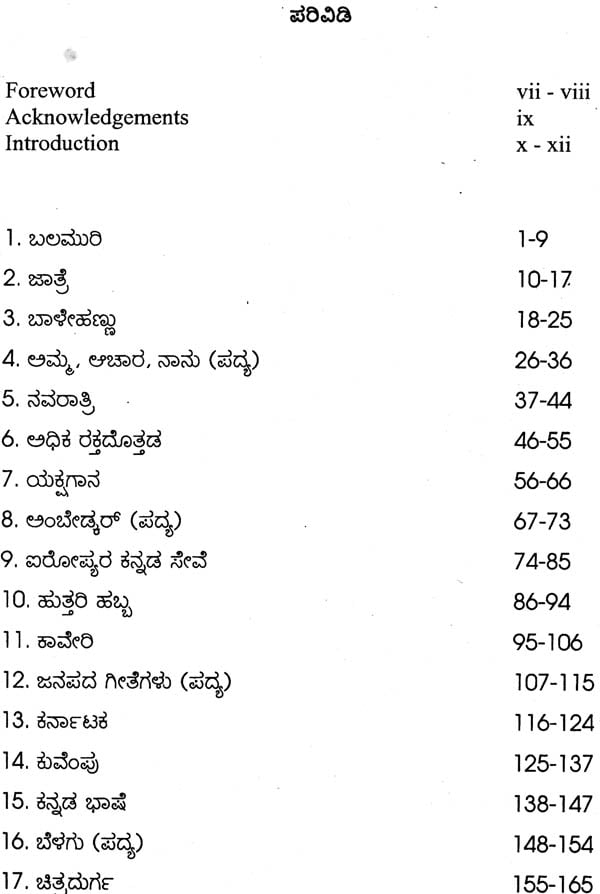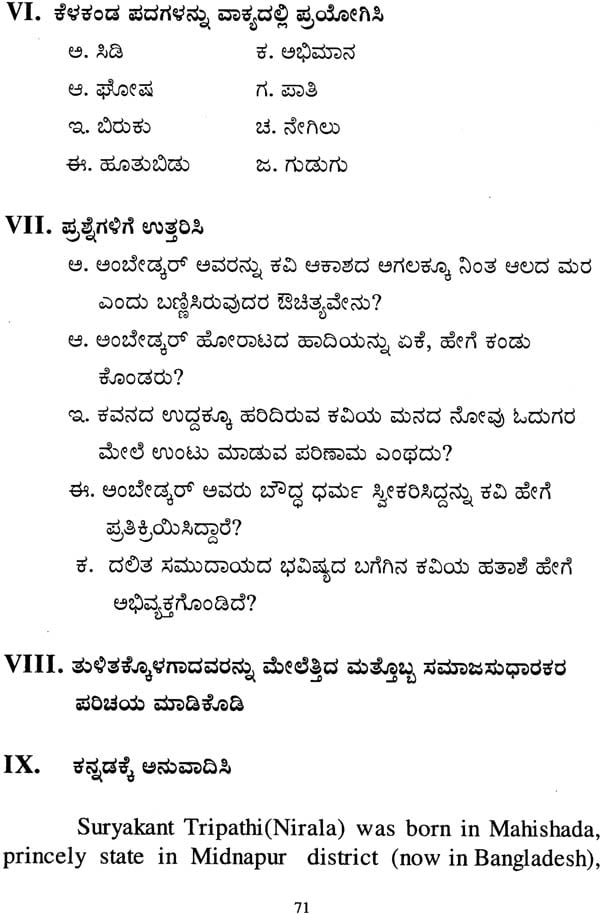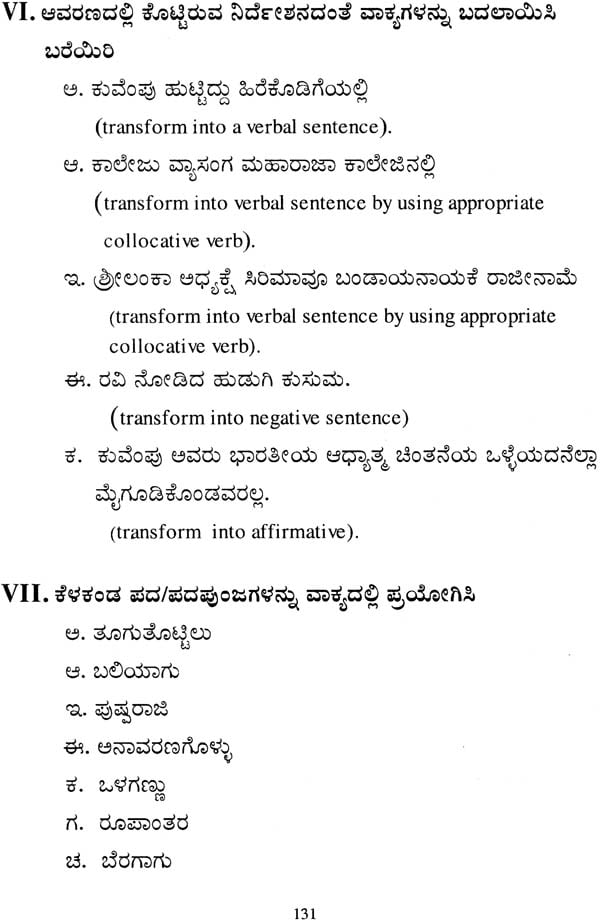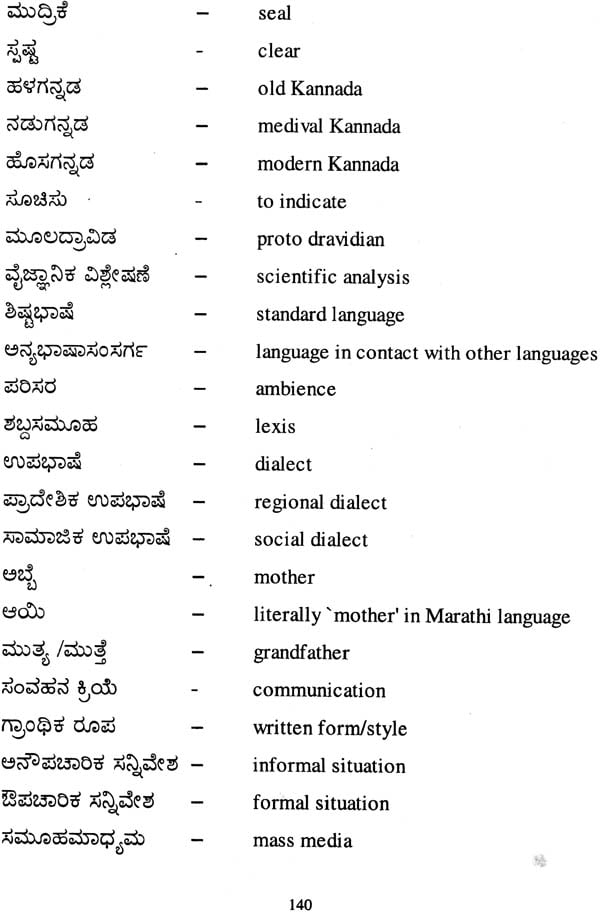
An Intermediate Course Reader in Kannada (A Rare Book)
Book Specification
| Item Code: | NAK157 |
| Author: | M.N.Leelavathi |
| Publisher: | Central Institute of Indian Languages, Mysore |
| Language: | Kannada and English |
| Edition: | 2004 |
| ISBN: | 8173421242 |
| Pages: | 227 |
| Cover: | Hardcover |
| Other Details | 9.5 inch x 7.0 inch |
| Weight | 500 gm |
Book Description
Disciplines merge, and then converge. Disciplines also emerge. Merger of disciplines could be best instantiated by what was once nicknamed as hyphenated linguistics (classical cases like 'Sociolinguistics and Psycho-linguistics' provided good examples, the latest being 'Geo-linguistics' growing on the ashes of what was once recognized as Dialect geography). These compounded disciplines show signs of merger very clearly as the stitches are quite visible. It takes long time to drop the hyphens and get more integrated. However, practitioners of these disciplines had their own dogma and learning history because of which they would usually try to push (or pull) the conjoined words (and worlds) apart (so much so that separate approaches would emerge).
But in the history of language sciences, several disciplines have emerged and have made their mark. They have emerged through a longer process of being together in a multally beneficial manner. In hard cover areas, phonetics and Semantics are two classical examples. In applied language science, Language teaching & is by far the best example of this kind. Here too one has seen ideas emanating from different disciplines and converging to create a common base. Some areas in Linguistics had always provided attractive meeting grounds for scholars with varied interests to work on. Some others emerged, but got sidelined again. (For instance, the once popular, Morphology, which bounced back as Word Formation , came up again as a point of focus with its original title). However there have also been disciplines which grew out of linguistics or from dissatisfaction of it, but later assumed a much bigger canvas large enough to involve people who like to be miles away from grammar. The emergence of Semiotics with Saussure, later practised as Semiology by modern greats as Rolland Barthes is a case in hand.
The areas such as language Teaching always attracted the faculty at the Central Institute of Indian Language and as a result, a lot of interesting materials got produced. The intermediate Course in Kannada has been produced in the same series by the Southern Regional Language centre of the Institute. They cover a wide range of writing styles used in the language so that both teachers and second language learners using them benefit from the lesson. The texts used here are not merely instances of ideal writing styles, they are also used to teach certain grammatical patterns and lexical coinages.
The language teaching materials produced by the Institute have so far been tried out through a series of 10 months Intensive Training Programme currently offered in the seven regional centres of the Institute at three levels: basic, Intermediate and Advanced courses. The present book is suitable to be used not only for such language learners who are to be taught as a part of our programme, but also for those who have not introduction to the language through a formal system, and yet have not had chance to go beyond the basics.
I congratulate the teachers who have used and perfected the material as much as the author, Dr. M.N.Leelavathi. The suggestions, comments, criticisms from all those who may use this teaching material will be most welcome.
This book 'An Intermediate Course in Kannada' is meant for the second stage of the 10 month language training programme in Kannada' of Southern Regional Language Centre of the Central Institute of Indian Languages. The Kannada Teacher Trainees having completed the intensive training in Basic Course for 450 hours following the structurally controlled and graded lesson, are slowly exposed to structure controlled free writing in the language. The materials in this book still follow a gradation as per usual norms of educational principles namely I. simple to complex ii. Known to unknown and iii. general to specific. No conscious attempt has been made to use only one particular type of sentence or vocabulary. Even then there is a steady progression from lesson 1 to 20. At the end of this second stage of training the trainees will be able to achieve the following objectives.
I. To converse freely with teachers, fellow trainees and native speakers on a variety of topics.
II. To read and comprehend materials presented in standard written language. The materials include pamphlets., booklets, newspapers, periodicals, short stories, essays etc.
III. To enrich the learners repertoire of words.
IV. To write free composition on a variety of Topics.
In a nutshell the Intermediate Course Reader is intended to be a sort of a bridge course which enables the learner to slowly move from the structurally and educationally graded materials to advanced free writing materials by established writhers in the language which constitute the last phase of the 10 month training programme.
This book contains 20 lessons out of which, 5 of them are poems from different poets of Modern times. In the selection of poems subject matter, simplicity and style and poetic effect were kept in mind. The content utilized for reinforcement of structures and introduction of new words included cultural, historical geographical, literary, social and political aspects of karnataka. Attention has paid to present variety and also to include an interest in the learner to know more and more about Karnataka and its people.
At the end of each lesson, the new lexical items have been glossed in the order of their occurrence in the text. For every new word, meaning has been given in English. Wherever such a word occurs whose synonym has already appeared in this book, that synonym is given as the meaning.
In most of the contexts meanings given are true to the context but wherever necessary, one or more additional meanings have also been provided especially if they are likely to contribute to either a sharper understanding of the text, or to establish helpful relationship between the different meanings of a word. As far as possible an attempt is made to use new vocabulary in the text in a way that the learner can get its meaning exploiting the clues provided by the neighbouring words in the sentence as well as by its context.
Variety of exercises are given to each lesson. Exercise are intended to test comprehension, recollection of what has been read in the lesson and also to give practice in the use of vocabulary build up. An exercise common to almost all lessons is making use of words in sentences. Another exercise is on derivation. This exercise exposes the learner to different kinds of formation, from one part of speech to another. Yet another type of word building with word discrimination to exploit rich possibilities of suffixation and prefixation and compounding processes. The main purpose throughout the book, is however, to help the learner add substantially to his word hoard.
Exercises contain both objective and open ended types. The author has also provided for skills as well as translation.
The book contains an index of words alphabetically arranged.
Even though this book is prepared keeping in mind the teacher trainees of Southern Regional Language Centre, it could be used meaningfully by any Kannada learner who has acquired the basic structural patterns and vocabulary of the language and would like to enrich their kannada.











